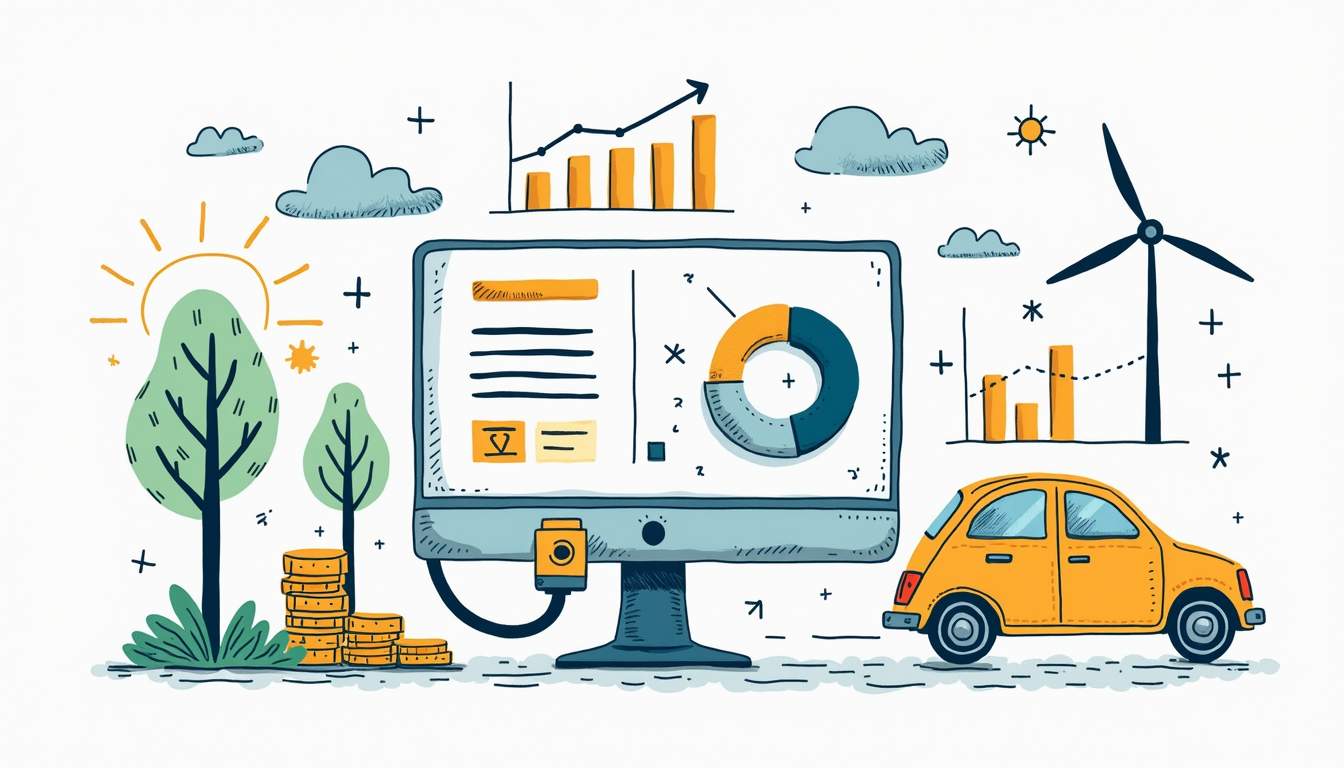In the rapidly evolving field of renewable energy, businesses are constantly looking for effective ways to promote their solutions. LinkedIn has emerged as a powerful platform for B2B advertising, allowing brands to connect with professionals and decision-makers. However, understanding the costs associated with advertising on LinkedIn is crucial for businesses aiming to maximize their return on investment.
Understanding LinkedIn Advertising Costs
LinkedIn advertising costs can vary widely, depending on several factors. To effectively navigate the landscape, it is vital to comprehend the pricing structure in detail. Advertisers typically pay based on several monetization models, including Cost Per Click (CPC), Cost Per Impression (CPM), and Cost Per Send (CPS) for sponsored InMail.
On average, advertisers can expect to pay anywhere from $2 to $8 per click on LinkedIn. However, particular niches may experience higher rates, especially those focusing on specialized sectors like renewable energy, which requires targeted advertising strategies to reach industry decision-makers. Understanding these nuances can help businesses better allocate their marketing budgets and maximize their return on investment.
Breakdown of LinkedIn Ad Pricing
The pricing for LinkedIn ads can be categorized into three primary models: CPC, CPM, and CPS. CPC is great for advertisers focused on driving traffic to their websites, while CPM is suited for businesses aiming for brand exposure. These models allow flexibility, making it easier for marketers to choose options aligned with their campaign goals. Additionally, LinkedIn offers a variety of ad formats, including sponsored content, text ads, and video ads, which can further influence the overall cost and effectiveness of a campaign.
Moreover, LinkedIn operates on an auction-based system, where advertisers bid for ad placements. This mechanism means that actual costs may fluctuate based on competition and ad relevance, making it essential to monitor campaigns regularly. Advertisers can also set daily or total budgets, providing them with control over their spending and enabling them to adjust their strategies based on performance metrics.
Factors Influencing LinkedIn Ad Costs
Numerous factors influence the costs associated with LinkedIn advertising. The most significant include the target audience, ad quality, and bidding strategy. Targeting specific demographics, such as industry professionals in renewable energy, may increase costs due to competition but can result in more relevant leads. The platform’s robust targeting options, including job title, company size, and geographic location, allow advertisers to hone in on their ideal audience, which can justify higher expenditure for potentially greater returns.
Additionally, the relevance and effectiveness of the ad content can directly affect costs. Higher quality ads may lead to lower overall costs due to better engagement rates. Evaluating these factors can aid in optimizing ad performance and budget allocation. Advertisers should also consider the timing of their campaigns; running ads during peak business hours or aligning them with industry events can enhance visibility and engagement, thereby influencing the overall cost-effectiveness of their advertising efforts. Furthermore, leveraging A/B testing can help identify the most effective ad variations, ensuring that marketing dollars are spent wisely and efficiently.
Advertising Renewable Energy Solutions
Advertising renewable energy solutions on LinkedIn is not just about placing ads; it involves creating a strategic plan tailored to the industry’s unique characteristics. Thorough audience analysis and ad customization are essential for effective engagement.

Importance of Target Audience in Renewable Energy Sector
In the renewable energy sector, targeting the right audience is crucial. Potential customers often include industries that rely heavily on sustainability, government agencies, and organizations committed to reducing their carbon footprint. By employing LinkedIn’s targeting capabilities, businesses can ensure that their ads reach the most relevant professionals.
For instance, utilizing features such as job title, company size, and industry can enhance targeting accuracy. As a result, companies can expect higher engagement rates and a better return on their advertising investment. Additionally, understanding the demographics of the audience, such as their geographic location and professional interests, can further refine targeting strategies. This level of precision allows businesses to connect with decision-makers who are not only interested in renewable energy but are also in a position to implement these solutions within their organizations.
Crafting Effective Ads for Renewable Energy Solutions
Crafting compelling ads involves a deep understanding of the audience’s needs and pain points. Advertisers must communicate the benefits of their renewable energy solutions clearly and effectively. Highlighting factors like cost-efficiency, sustainability, and long-term benefits can resonate well with potential clients.
Furthermore, utilizing eye-catching visuals and strong call-to-action statements is critical. Ads should not only inform but also inspire action, leading potential customers to learn more about the solutions provided. Incorporating testimonials or case studies can also enhance credibility and showcase real-world applications of renewable energy solutions. This approach not only builds trust but also demonstrates the tangible impact of adopting these technologies, making the ads more relatable and persuasive to the target audience.
Optimizing Your LinkedIn Ad Budget
To get the most out of your LinkedIn advertising budget, it is crucial to implement effective budget optimization strategies. This process involves monitoring performance and adjusting tactics accordingly to enhance overall engagement and minimize costs.

Strategies for Cost-Effective LinkedIn Advertising
Ad optimizations can significantly impact cost-effectiveness. Regularly reviewing ad performance and testing different formats and creatives can lead to better engagement rates. Moreover, leveraging A/B testing can help advertisers identify which ads yield the best results, allowing for informed adjustments.
Utilizing LinkedIn’s Insights Tag can also track conversions, attributing them to specific campaigns. This data is invaluable for understanding what’s working and where improvements are needed. Additionally, segmenting your audience based on industry, job title, or company size can help tailor your messaging more effectively, ensuring that your ads resonate with the right people. By focusing on niche segments, you can often achieve higher engagement rates while spending less on broader, less targeted campaigns.
Measuring Return on Investment for LinkedIn Ads
Measuring ROI is critical for any advertising campaign. On LinkedIn, businesses should focus on both direct and indirect benefits. Direct benefits can include leads generated, while indirect benefits may encompass brand awareness and market positioning.
Utilizing analytics tools can provide insights into campaign performance, enabling businesses to calculate their ROI accurately. The effectiveness of LinkedIn ads for renewable energy solutions should be continuously evaluated to determine the overall value of advertising efforts on the platform. Furthermore, integrating CRM systems with LinkedIn can enhance tracking capabilities, allowing businesses to follow leads through the sales funnel and better understand the long-term impact of their advertising spend. This holistic view not only aids in refining future campaigns but also helps in justifying budget allocations to stakeholders by showcasing the comprehensive value generated from LinkedIn advertising initiatives.
LinkedIn Advertising vs Other Social Media Platforms
When considering advertising strategies, comparing LinkedIn with other social media platforms is essential, especially for businesses in the renewable energy sector.

Cost Comparison of LinkedIn and Other Platforms
In general, LinkedIn advertising tends to be more expensive than platforms like Facebook or Twitter. However, the higher costs are often justified by LinkedIn’s ability to connect businesses directly with relevant professionals and decision-makers. Investing in LinkedIn can yield better quality leads, especially when targeting specific industries.
For example, while Facebook may generate a larger audience reach, LinkedIn offers more precise targeting tools that appeal to B2B advertisers, which is particularly beneficial for the renewable energy niche.
Moreover, the cost per click (CPC) on LinkedIn can be higher, but the return on investment (ROI) can also be significantly greater. This is due to the platform’s unique ability to filter audiences based on job title, industry, and even company size. For renewable energy companies, this means that every dollar spent is more likely to result in meaningful interactions with potential clients who have the authority to make purchasing decisions, ultimately leading to more successful campaigns.
Effectiveness of LinkedIn Ads for Renewable Energy Sector
Numerous studies have shown that LinkedIn ads tend to have higher engagement rates among professionals compared to other platforms. In the renewable energy sector, where decisions often involve multiple stakeholders, the ability to reach these influencers is invaluable. Furthermore, the professional context of LinkedIn enhances the credibility of ads.
Ultimately, the effectiveness of LinkedIn advertising can significantly benefit businesses promoting renewable energy solutions, as it cultivates a focused platform for building relationships and partnerships within the industry. Additionally, LinkedIn provides various ad formats, such as sponsored content, InMail, and dynamic ads, which can be tailored to suit specific campaign goals. For instance, sponsored content can showcase case studies or white papers that highlight innovative renewable energy technologies, while InMail can facilitate direct communication with key decision-makers, fostering a more personalized approach to outreach.
Furthermore, LinkedIn’s analytics tools allow advertisers to track the performance of their campaigns in real-time, enabling them to make data-driven adjustments to optimize their strategies. This level of insight is particularly advantageous for renewable energy companies that may need to pivot quickly in response to market trends or emerging technologies. By leveraging these tools, businesses can ensure that their advertising efforts are not only effective but also aligned with the evolving landscape of the renewable energy sector.
Conclusion: Is LinkedIn Advertising Worth the Cost for Renewable Energy Solutions?
In conclusion, while LinkedIn advertising can be more expensive than other social platforms, the potential for reaching highly targeted professionals in the renewable energy sector makes it a worthwhile consideration. Companies that effectively strategize their ad campaigns, specifically focusing on their audiences and crafting compelling content, can maximize their return on investment.
Ultimately, understanding LinkedIn advertising costs and optimizing spend will allow businesses to make informed decisions, ensuring that their promotional efforts align with their overall marketing strategy. As the renewable energy sector continues to grow, utilizing LinkedIn as an advertising platform could prove to be a pivotal move in staying competitive.